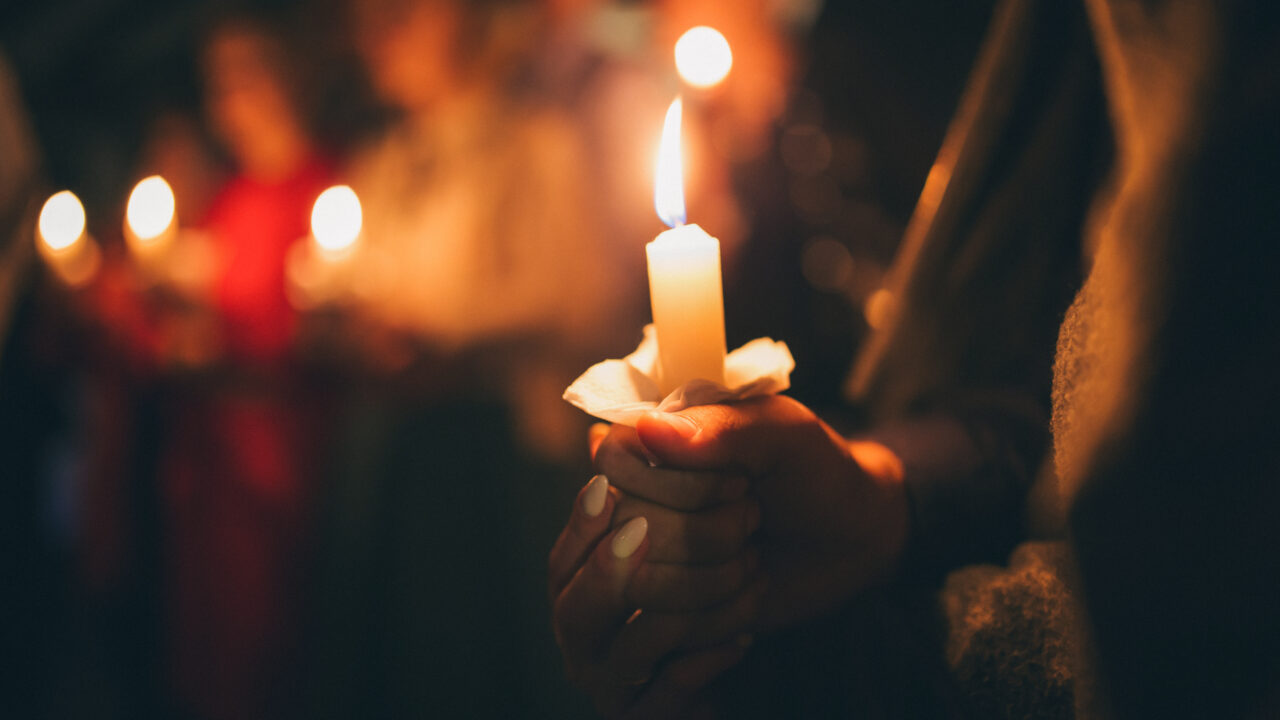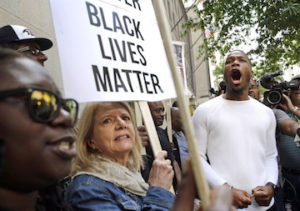Inside the Growing Movement To Hold Space for Community Grief
Beginning as a response to environmental trauma, proponents of the trend seek to bring ritual back to a culture that has growingly become "grief-illiterate."
White tarp tents lined one side of Allston Way in Berkeley, California, on a sunny week in early April 2023, beneath which a cluster of people sat on ornate pillows, sipping from ceramic cups at the tea ceremony booth. Others filtered to and fro, sometimes stopping to peruse the flyers and stickers that were fanned out on the fold-up tables, or to participate in group art projects. This city block, adjacent to the illustrious University of California campus, was transformed into a marketplace as part of the Bioneers Conference—an independent annual event focused on environmental and social justice solutions that began in 1990 in the Bay Area (though 2023 was its first time taking place in Berkeley).
At one end of the street, rotating passersby painted large-form mural versions of activist art posters onto the asphalt. Nestled near the painters was an unassuming white tent similar to the others except for the addition of white tarp “walls” that were intermittently velcroed closed. Inside, candles flickered between altars made from moss, lichen, sticks, rocks, dried leaves, and flowers. Paper and pens were laid out with a note inviting people to write out their joys and sorrows. This was the grief tent, which offered public grief rituals, free to all throughout the week of Bioneers, conference-goer or not.
People inside sat in a circle on folding chairs, taking slow, deep breaths in unison, as a facilitator guided them through a meditation to connect with their bodies, their breath, their hearts, and the earth. Then, the circle was invited to bring their attention to something in nature that they loved, and something in nature that they mourned. Next, one by one, each person was invited to share about what came up for them. As eyes welled up with tears, people passed a box of tissues across the circle to one another.
There was a long, natural pause following each person’s turn, as the space grew silent and the circle hummed with a sense of mutual understanding, and shared loss.
Birgitta Kastenbaum, an end-of-life guide, death midwife, and doula who offers grief-tending through Bridging Transitions in Los Angeles, co-facilitated grief rituals, including this eco-grief circle, throughout each day of Bioneers 2023.
She says that because the Bioneers Conference is largely focused on ecological healing and activism for people and the planet, the subject matter carries with it immense grief for many.
“We started to have grief circles [at Bioneers] because we started to recognize that there was an extreme need for people to share,” she says.
Grief circles throughout the conference varied—some focused on more general, all-inclusive grief, and others focused more specifically on subjects like “eco grief” or “death and dying.” All were free, and open to the public.
She says the idea to include grief in the conference initially came out of panel discussions on end-of-life care and intentional dying that she, Anneke Campbell (an activist who works as a writer, filmmaker, poet, midwife, and yoga teacher), and others were having. This prompted a conversation among organizers, and eventually led to the public grief tent.
Eco Grief
“We also started noticing that there were a lot of people who were having eco grief,” Kastenbaum says—especially among lifelong activists who had spent years standing up for the planet only to be knocked down over and over again. “[Activists] have had to rise up to be pushed back down, and there was a sense of hopelessness and grief. It became clear that there was a desire for people to have spaces where this could be expressed, in a circle where communal grief was at the center.”
Ecological grief, or the grief we experience due to the human-caused destruction of nature and climate disasters, has become an increasingly common experience for many in the 21st century. As we enter the Anthropocene epoch in which human activity has the most dominant impact on the planet’s environment, therapists have been overwhelmed with clients experiencing the mental health effects of our times. Mental health experts have been grappling with what to do, and there has been an increasing call for psychological research into ways of dealing with eco grief and eco-anxiety.
Kastenbaum says she thinks the reason grieving circles like the one at Bioneers have the potential to work for anyone, even strangers off of the street, is that universally we want to be witnessed, in our grief.
“There’s something about recognizing that you are not alone,” she says. “Sitting in a circle, you hear everybody’s stories and see that there’s this communal thread, this tapestry, that we’re all a part of. And each thread is different, but when we weave together, it makes us stronger.”
Kastenbaum says that the organizers behind the Bioneers Conference’s grief tent wanted to help people see how easy it is to do grief-tending work. She says all it requires is to create a space that feels safe—whether that happens in your living room, in a park, or somewhere else.
“There has to be a sense of safety for people to be able to share—so that can mean setting a little bit of ground rules around what it means to sit in this particular circle, and how we are going to hold each other,” she says. “But then, that’s it. We are just being present to one another. The hope is that there was a little bit of a spark there, like, ‘Ah, I could possibly do this too.’”
Remembering How to Grieve
Kastenbaum has lived in the U.S. for decades, but was raised in a small rural community in the Netherlands, where she grew up witnessing the cycles of birth and death—both of which often happened in the home. Her father was a child Holocaust survivor, and she says due to the resulting fear and trauma, grief was an ever-present element of her upbringing.
“Maybe the beauty that I can see now, but I didn’t see then, is that you learn to walk with grief,” she says. “You learn to hold it, in a way, as a constant companion—while at the same time having joy in life and being excited about the future… but it’s never gone.”
While grief is a natural process and healthy response to life events, Kastenbaum points out that—especially in the U.S. and other modernized Western European cultures—many people today tend to be what she calls “grief illiterate.”
However, this is not the case everywhere in the world.
“The only thing we know about grief [in U.S. society] is that you’re not supposed to have it—and if you have it, you’ve got to get rid of it,” she says. “When we look at other places the world over, we see that they have ways in which they hold grief.”
She says those ways can be as simple as an altar with a photograph and a candle or a prayer that is repeated each morning. Or, they might be as complex as a weeklong festival dedicated to grief and mourning, with myriad traditions and rituals throughout.
She points out that the language presented around grief is often focused on “getting over it” and “getting through it.” She noticed this especially in the language of resources she found when she began offering grief-tending work focused on death and dying around 2012.
“It was presented as something really negative,” she says. “There was a sadness for me in that, because with our grief, we also hold onto love. With our grief, we hold onto memories. They are intertwined. Often when we push away grief, we’re pushing away our memories, our love, all the beauty, all the wisdom, all the gifts that come with that process.”
Francis Weller, a well-known psychotherapist who guides grieving circles and teaches people to facilitate grief-tending work, writes in his book The Wild Edge of Sorrow: Rituals of Renewal and the Sacred Work of Grief:
“Grief and love are sisters, woven together from the beginning. Their kinship reminds us that there is no love that does not contain loss and no loss that is not a reminder of the love we carry for what we once held close.”
While our culture may continue to tip-toe around grief, there is a movement by people like Weller, Kastenbaum, and many others for a revival of shared grief work. Many people around the U.S. and the world facilitate community grieving circles and rituals. For example, Dani Leonardo (who trained in grief facilitator with Francis Weller) offered community grief circles in Ashland, Oregon following devastating fires as well as racist violence that took place in 2020 and 2021, which is detailed in my article “How Making Space for Grief Can Promote Community Healing,” originally published in 2021.
There are many grief circle facilitation trainings and resources available around the U.S. and world, including the Unitarian Universalist Association’s guide for hosting virtual grief circles, trainings through the Good Grief Network or the Center for Grief and Loss, as well as trainings offered by individual grief professionals like Weller and many others.
Rituals for Grief
Kastenbaum notes that we all have the natural capacity to process grief through ritual.
“I think by nature, we are ritual makers—we just are,” she says, noting the way that children will often create rituals around grief on their own, whether that means speaking words, writing a note, making a drawing, or collecting a bouquet of dandelions to place over a buried hamster.
“When something dies, or something painful happens, children pause,” she says. “They naturally have that ability to create ritual. We might be adults, but that’s still in us.”
Ritual has been intrinsic to human life for millennia, and ritual likely played a foundational role in the creation of early human societies according to research in human evolution. Social psychologist Shira Gabriel spoke to how important shared ritual is to our mental health, in an article titled “What Happens When We Lose Our Social Rituals?” by Jill Suttie, published in 2020 in Greater Good Magazine.
Gabriel’s research shows how rituals, defined as “choreographed events that produce an emotionally laden experience,” help to bond us with others and create meaning in our lives.
“Rituals give us a feeling of going beyond the ordinary—of having a moment that transcends that, turning events into something special and meaningful,”
Gabriel is quoted as saying in the article.
Suttie explains in the article that this is “transcendent” because
“when we participate in ritual, we experience a sort of emotion contagion that sociologist Émile Durkheim called ‘collective effervescence.’ That uplift and energy increase our sense of commonality (even with strangers) and make us feel we are part of a larger community.”
Kastenbaum points out that the size of a ritual does not equate to its meaning. Small and simple rituals can be just as powerful as grand, ornate gestures, she says.
“Lighting a candle every night for somebody you are actively grieving—that could be immense in the quality of the meaning that you are creating,” she shares.
She says ritual has meaning for us as humans, and without ritual for something as intense and transformative as grief, there is often a significant sense of disconnect.
Rituals, especially when they take place with other people, are how most of us want and need to make sense of grief, Kastenbaum says.
She notes that therapy can be helpful, ritual can often be a more connective way to process grief.
“We don’t want to just book an appointment and sit across from somebody for an hour and tell them everything that’s wrong with us,” she says. “That’s not how to honor grief. That’s not how to hold grief.”
In fact, ritual is likely the reason some people recover from loss more quickly and more completely than others. Rituals performed following loss, was the one factor more emotionally resilient mourners have in common, according to the results of a study titled “Rituals Alleviate Grieving for Loved Ones, Lovers, and Lotteries” published in the Journal of Experimental Psychology in 2014 and conducted through the Harvard Business School.
In addition to public grief circles, the grief tent at Bioneers also offered people the chance to participate in co-creating a communal altar, made from natural objects (like moss, lichen, sticks, and rocks). Paper and pens were laid out, too, and people were invited to write out their grief, and tuck notes into the altar.
“The idea was that grief needs a space to lay, to be able to rest,” Kastenbaum says, noting that people were invited to “lay down” their grief at the altar. “The beauty is that this altar was alive. It was fed by our grief and transformed,” she says. “When we started on the first day, there were very few things on the table. And at the end it was filled. And that, too, is something really powerful for people to see: how we can transform something… From this grief, we created beauty.”
She says this is something anyone could easily do at home, share in their community, or incorporate into a memorial. She says all it takes is to create a dedicated space for people to write or to gather natural elements to symbolize their grief, and witness the transformation together.
Your support matters…Independent journalism is under threat and overshadowed by heavily funded mainstream media.
You can help level the playing field. Become a member.
Your tax-deductible contribution keeps us digging beneath the headlines to give you thought-provoking, investigative reporting and analysis that unearths what's really happening- without compromise.
Give today to support our courageous, independent journalists.





You need to be a supporter to comment.
There are currently no responses to this article.
Be the first to respond.